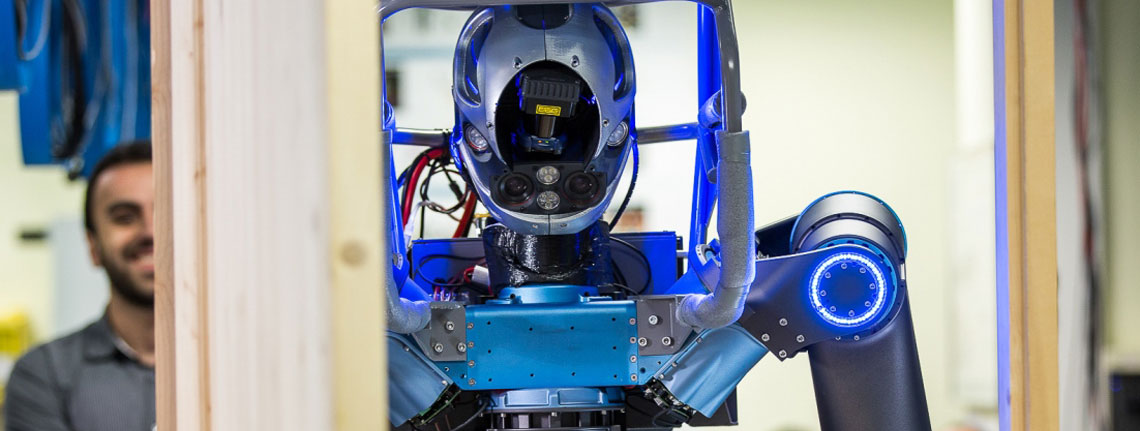Teleoperation

The need to manipulate objects and tools in unstructured or hostile environments has led to the development of several Master-Slave teleoperation interfaces: from the most basic, unilateral position-based, to bilateral force-reflecting systems. Notwithstanding the widespread use of such frameworks, they are known to lack substantial requirements to render an appropriate interaction performance (e.g. soft interactions in unilateral and stability in the latter). Therefore, the main objective of this theme is to address such limitations by the development of novel and intuitive interfaces for the execution of dynamic remote manipulation tasks. Our first objective is to extend the recent developments at HRI2 laboratory on the teleimpedance control of compliant robotic arms to a large number of degrees of freedom, e.g. humanoid robots.
Research activities in this field will additionally investigate the feasibility of merging our novel techniques in Body-Machine Interfaces (e.g. teleimpedance) and Brain-Machine Interfaces with force or wearable haptic feedback for improved stability and transparency.
On the robot side, we aim at integrating the underlying human motor control principles into the target robots’ control architectures to potentially improve interaction performance and redundancy resolution, while decreasing the robot control burden. The main reserach activities carried out in this direction, can be desribed as follows
Tele-impedance Control
Tele-impedance control [1] is a method for remotely controlling robotic platforms in interaction with uncertain environments. As an alternative to bilateral force-reflecting teleoperation control, in tele-impedance a compound reference command is sent to the slave robot including both the desired motion trajectory and impedance profile, which are then realized by the remote controller without explicit feedback to the operator. In Tele-impedance, the reference commands are extracted from a body-machine interface (BMI) applied to the master operator's limb (arms, legs, etc.), using only non-intrusive position and electromyography (EMG) measurements, and excluding any feedback from the remote site except for looking at the task. Example applications are Tele-impedance control of robotic arm , an anthropomorphic, synnergy-driven robotic hand, among many.
Our current work [2] in this direction focuses on the implementation of reduced-complexity models of the human physical interaction behaviour, using a minimum number of sensory information, an example video is available for the remote impedance control of a compliant robotic arm.
- A. Ajoudani, N. G. Tsagarakis, and A. Bicchi. Teleoperation with Impedance Regulation Using a Body-Machine Interface. International Journal of Robotics Research, 31(13), 1642–1655, 2012.
- A. Ajoudani, C. Faneg, N. G. Tsagarakis, and A. Bicchi, "A Reduced-Complexity Description of Arm Endpoint Stiffness with Applications to Teleimpedance Control", IEEE International Conference on Intelligent Robots and Systems (IROS), 2015.
Tele-impedance Control with Haptic Interfaces
We aim to present an integrated approach for augmented tele-operation where wearable hand/arm pose under-sensing and haptic feedback devices are combined with teleimpedance techniques, for a simplified yet effective position and stiffness control of synergy-inspired robotic manipulators in real-time. A video of the work is available here, in which a Kuka lightweight robotic arm equipped with the Pisa/IIT SoftHand, is controlled in impedance to perform a drilling task, an illustrative example of dynamic tasks with environmental constraints. Experimental results on ten healthy subjects suggest that the proposed integrated interface enables the master to appropriately regulate the stiffness and pose of the robotic hand-arm system through the perception of interaction forces and vision, contributing to successful and intuitive executions of the remote task.
- S.Fani, S. Ciotti, M. Catalano, G. Grioli, A. Ajoudani, and M. Bianchi, "Integrating Wearable Haptics and Teleimpedance Methods for Augmented Human-Robot Interaction with Synergy-inspired Robotic Systems", IEEE Robotics and Automation Magazine (RAM), 2017.
Tele-impedance Control with Force Feedback
Tele-impedance control offers advantages in certain conditions, e.g. where master-slave communications are low quality. However, force feedback remains necessary when visual feedback is impaired or transparency and telepresence in the remote environment is of major concern. In this reserach direction (see for example [1]), we work on a novel framework to achieve the Tele-Impedance with Force Feedback (TIFF) so as to have a seamless control scheme that subsumes the performance advantages of both, while still guaranteeing stability and transparency.
- M. Laghi, A. Ajoudani, M. Catalano1 and A. Bicchi, "A Bilateral Tele-Impedance Controller for Remote Interaction with Transmission Time Delay", IEEE International Conference on Intelligent Robots and Systems (IROS), 2017.
Soft Brain-Machine Interfaces (Soft BMI)
This line of research aims at exploring the potential of a novel soft Brain-Machine Interface (BMI), suitable for a wide range of operators, for dynamic execution of remote tasks. The interface is composed of an eye-tracking system, for an intuitive and reliable control of a robotic hand-arm system's trajectories, and a brain-computer interface unit, for the estimation of the desired task accuracy (and force) which is associated to the robot Cartesian stiffness. The latter is achieved by the estimation of a unidimensional concentration index in real-time and replicated by the robot's impedance controller. An example video of the setup is available to provide solid evidence on the effective execution of tasks with dynamic uncertainties, highlighting the potential of the proposed approach in applications such as self- service and clinical care.
- L. Schiatti, J. Tessadori, G. Barresi, L. S. Mattos, and A. Ajoudani, "Soft Brain-Machine Interfaces for Assistive Robotics: A Novel Control Approach", International Conference on Rehabilitation Robotics (ICORR), 2017.
